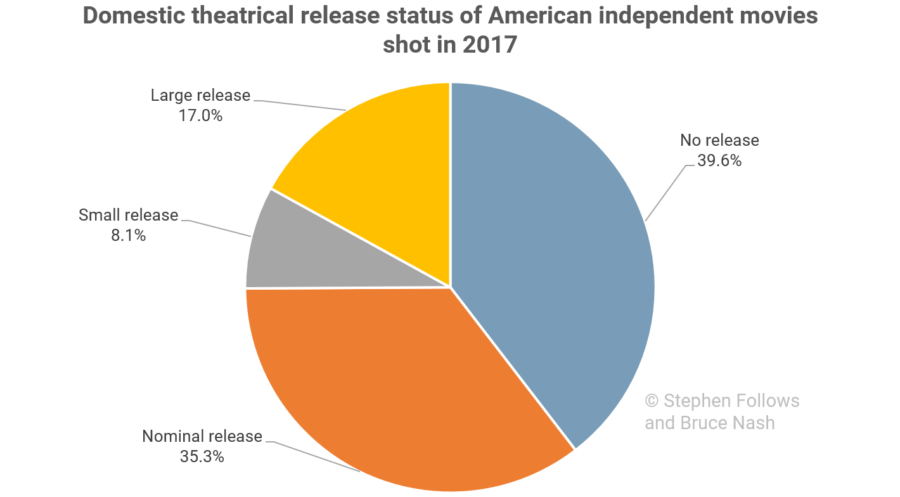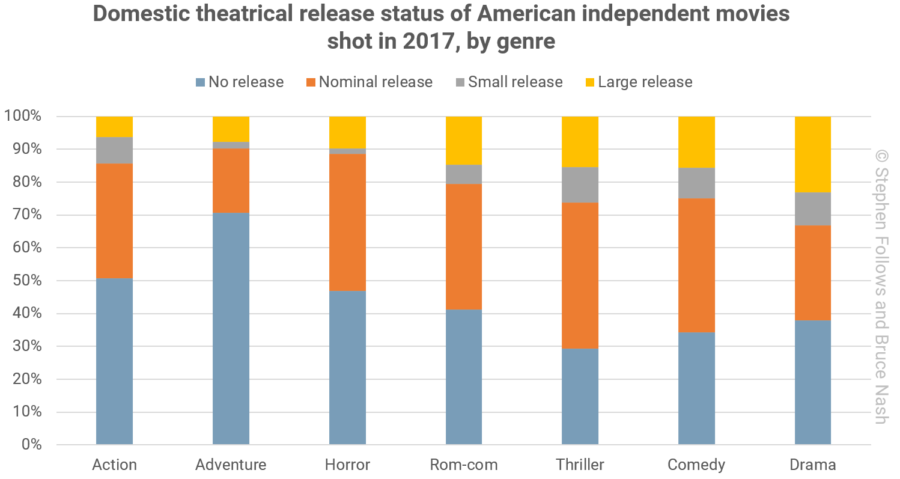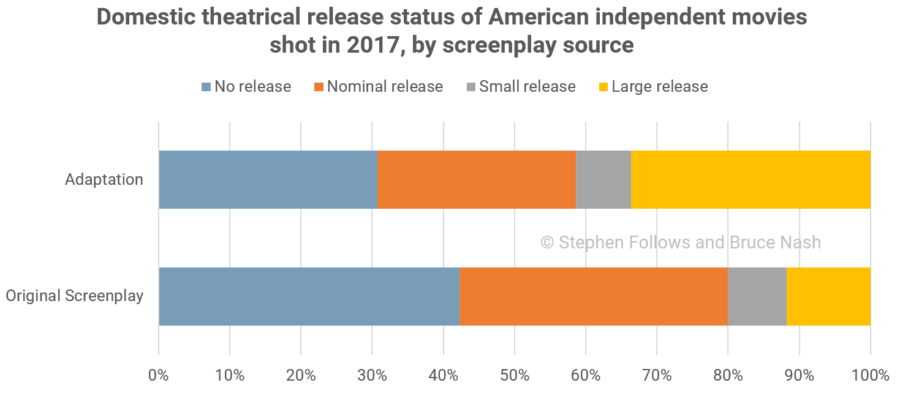 For many independent filmmakers, whether or not their film reaches the big screen means everything. No matter the money to be made via television deals or the massive audiences possible with VOD, a theatrical release is where it’s at.
For many independent filmmakers, whether or not their film reaches the big screen means everything. No matter the money to be made via television deals or the massive audiences possible with VOD, a theatrical release is where it’s at.
In a new piece of research for the American Film Market, Bruce Nash and I set out to discover how many films actually make it to cinemas.
We built a dataset of all United States-produced narrative (non-documentary) feature films which were shot in 2017 and looked at their distribution outcome.
What is a theatrical release?
Before we get into the details, we need to be a little bit careful about our definition of a “theatrical release”. For example, it isn’t really fair to compare a film that plays for a group of friends and family in a cinema rented by the director to a three-month cinema engagement.
We split films into four possible outcomes (in all cases, we’re talking about the “Domestic” market, aka the United States and Canada).
- No theatrical release – These films had no commercial theatrical release domestically. They may have had a premiere in a cinema, and played in film festivals, but they never announced a theatrical release for paying customers.
- Nominal release – These films officially have theatrical release dates but no box office figures have been reported, meaning that it was very likely to have been an extremely small release, possibly in just one or two cinemas.
- Small release – Films which grossed between $1 and $100k at the domestic box office.
- Large release – Films which grossed over $100k at the domestic box office.
We excluded 123 films made in 2017 and subsequently released by one of the major studios, so we’re looking only at independent films in this analysis.
This revealed that 40% of independent films made in 2017 did not get any kind of theatrical release.
A further 35% had a nominal release, with no reported box office; 8% grossed between $1 and $100k; and 17% grossed over $100k. Out of the 877 independent films, 220 reported earnings at the box office, which is a shade over 25%.

Common sense dictates that independent film-makers should have a back-up plan for a home market release for their film. That said, we wanted to see if different genres might be more or less likely to get that coveted place in cinemas.
How different are the release outcomes for films of differing genres?
It turns out that genre plays quite a big role in the type of release a film will get.

Among the films most likely to get no release at all are ones we classify as adventures. These tend to be family-friendly films that involve a certain amount of action, but no real peril – films with names like Camp Cool Kids and Sweet Sweet Summertime. They are often made for TV, or go directly to DVD or a streaming platform. In all, 71% of independent adventure films don’t play in cinemas. The second and third most likely films not to play in cinemas are the classic “genre films”: action and horror, at 51% and 47% respectively.
The films most likely to get a nominal release are thrillers, at 45%, followed by horror (42%) and comedy (41%). As we mentioned earlier, a nominal release implies that getting reviews (hopefully good ones!) will help the financial fortunes of a film. So it makes sense that the films with nominal releases are the ones that would benefit from good reviews.
Small releases are dominated by dramas, comedies, and thrillers. 11% of thrillers, 10% of dramas, and 9% of comedies get a small release. These are films that were probably hoping to get good word of mouth and decent earnings from cinemas, but maybe just fell short.
Finally, large releases are the realm of the drama, with 23% of independent dramas earning over $100,000 at the domestic box office. Comedies (16%) and thrillers (15%) are also more likely to get into this top tier.
We don’t know why, but romantic comedies don’t really stand out one way or another in this analysis: their release profile is almost exactly the same as for the market as a whole. We don’t perhaps think of romantic comedies as the typical film, but they have typical distribution chances.
How does having a pre-existing audience correlate with a theatrical release?
Studio-produced films are much more likely to be adaptations than independent films, for a number of reasons (such as studios having deeper pockets and needing to secure bigger crowds to break even). Overall, about half of studio-produced films are based on pre-existing material.
Although rarer, there are still a lot of independent films that are adaptations of one sort or another. Over 200 of the films in our dataset, or 24% of the independent films, are not original screenplays. Most of these are based on real-life events or books, but there’s a wide range of sources used in independent films including short films, web series, games, toys, musicals, religious texts, and plays, among others.
These adaptations are three times as likely to secure a large theatrical release compared to independent films with original screenplays. That’s a significant jump, and shows how hard it is for an independent film based on original material to get a substantial theatrical release. As we’ve shown in a previous article, to get into this top bracket, an original film needs to be of the highest quality. In general, as one would expect, distributors are much more likely to put resources behind a film that they know has an existing audience.

Conclusion
Seeing a film played in a cinema is still regarded as the best way to experience the art form. It’s also, understandably, the goal of many film producers. By looking at a complete set of films made in a single year, we can see how likely it is that a given film will realize that dream, and it turns out that there’s actually a pretty good chance a film will play to a paying audience at some point, if that’s what the film-maker sets out to do.
However, the numbers say that an independent film will, five times out of six, not go on to make much money in cinemas. Knowing how to maximize revenue from the home market remains an essential skill for an independent producer.
Notes
All the films studied today are feature films shot in the United States, or made by US-based production companies, and completed in 2017. It’s possible that some of these films have not yet reached cinemas, and so in the fullness of time the figures may change slightly. That said, we are conducting this research in mid-August 2019 and so the vast majority of films have either reached cinemas or never will.





Comments
Thanks for this Stephen. I teach screenwriting at a university and will give this as a hand out in my adaptation class!
Given the marketing costs required to attract attention to North Ametican cinema releases, I wonder how badly profitability is impacted by those lucky few independent films who only get a small or nominal release and have to amortize distribution costs against subsequent revenue from other platforms.
As a newcomer to your site, I am impressed by the clarity of the information and conclusions. I am researching international co-production as a PhD candidate and statistical and industry information is valuable and not always easy to come by. It will be interesting to see if the US experience is mirrored by UK, Australian and Canadian films. I suspect the pattern will be the same.
Thank you Stephen! As always, this big picture analysis is enlightening and clear. I’m curious to see how documentaries would do in this breakdown.
Then there is this wonderful example that gives hope for us low budget film-makers!
https://en.wikipedia.org/wiki/Once_(film)
Thank you for the analysis. I’m very happy to see this British indie sci-fi film, shot for just $8k, to get a theatrical release in the US next month: https://www.youtube.com/watch?v=4j-PzuxcKcc The two brothers writers-directors managed to get a major distributor early on. 5 years in the making, that film, finally is coming out!